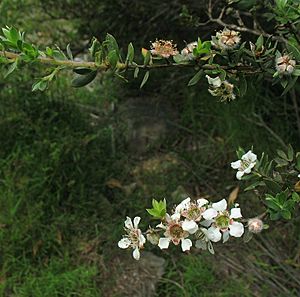Monga tea-tree facts for kids
Quick facts for kids Monga tea-tree |
|
|---|---|
 |
|
| Near Clyde Mountain | |
| Conservation status | |
| Scientific classification | |
| Genus: |
Leptospermum
|
| Species: |
thompsonii
|
The Monga tea-tree (scientific name: Leptospermum thompsonii) is a type of tall bush found only in southeastern New South Wales, Australia. It has bark that feels rough and peels off in flakes. Its leaves are shaped like an egg, wider at one end and pointy at the tip. This plant also grows pretty white flowers and produces fruit that stays on the plant even when it's ripe.
Contents
What Does the Monga Tea-Tree Look Like?
The Monga tea-tree is a straight-growing bush that can reach a height of 1 to 6 meters (about 3 to 20 feet). It has rough bark that can be fibrous or flaky. Its younger stems are covered with soft, fine hairs.
Leaves and Flowers
The leaves of the Monga tea-tree are shaped like an ellipse or an egg, with the narrower part closer to the stem. They are usually 10 to 15 millimeters (about 0.4 to 0.6 inches) long and 4 to 6 millimeters (about 0.16 to 0.24 inches) wide. Each leaf has a sharp, pointed tip and a short stalk called a petiole.
The flowers are white and about 15 millimeters (0.6 inches) wide. They grow one by one on short side branches. The base of the flower, called the floral cup, is covered with soft hairs and is about 4 millimeters (0.16 inches) long. The sepals, which are like small leaves protecting the bud, are also hairy and broadly egg-shaped, about 3 millimeters (0.12 inches) long. The five petals are 4 to 6 millimeters (0.16 to 0.24 inches) long, and the stamens (the parts that produce pollen) are 2 to 3 millimeters (0.08 to 0.12 inches) long.
When Does It Flower and Fruit?
Monga tea-trees usually flower from December to March, which is summer in Australia. After flowering, they produce a fruit called a capsule. This capsule is about 10 millimeters (0.4 inches) wide and stays on the plant even after it's mature.
How the Monga Tea-Tree Got Its Name
The Monga tea-tree, Leptospermum thompsonii, was officially described in 1989. A botanist named Joy Thompson gave it its scientific name. She published her description in a science journal called Telopea.
The second part of its scientific name, thompsonii, honors M.M.H. Thompson. He was Joy Thompson's husband and helped her a lot with collecting and studying this plant and many others in nature.
Where Does the Monga Tea-Tree Live?
The Monga tea-tree grows in places that are always moist or wet, usually within forests. You can find populations of this tea-tree in a few national parks in New South Wales:
- Monga National Park
- Budawang National Park
- Morton National Park
Why Is the Monga Tea-Tree Important?
The Monga tea-tree is listed as "vulnerable" by the Australian Government. This means it's a species that could become endangered if we don't protect it. The New South Wales Government also lists it as vulnerable.
What Threats Does It Face?
Some of the main dangers to the Monga tea-tree include:
- Changes in fire patterns: Too many fires or fires at the wrong time can harm the plants.
- Forestry activities: Logging or other forest work can disturb its habitat.
- Rubbish dumping: Trash left in its habitat can damage the environment.
- Oil spills: Accidents that cause oil to spill can pollute the areas where it grows.
Protecting these areas and managing them carefully helps keep the Monga tea-tree safe for the future.


